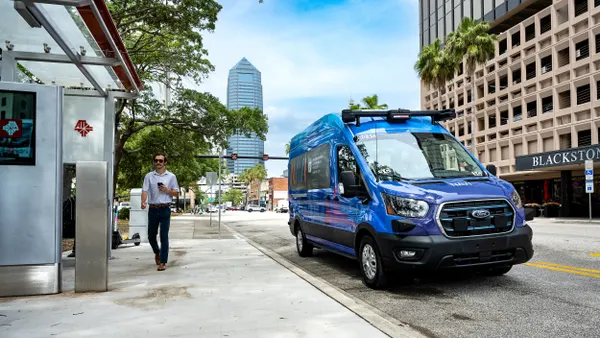Dive Brief:
- A report this month released by the American Public Transportation Association (APTA) offers a methodology for governments and stakeholders to evaluate the broad social, economic and environmental benefits of passenger rail projects that advocates say government reviews can often miss.
- The report, which APTA released along with a benefit evaluation toolkit, advocates for a private sector “business case” for investment with a return on investment (ROI) formula that includes wide-ranging benefits to rail development, like community investment, cleaner air and access to more economic markets. That approach, APTA said, can help build broad support for investment in passenger and high-speed rail.
- “The traditional benefit-cost analysis has a very narrow definition of user benefits that does not cover or capture or recognize the importance of a lot of things that are important to communities and residents,” said economic analysis firm EBP's Glen Weisbrod, one of the report authors, at a virtual APTA conference. “The concept here is to redefine the public return on investment.”
Dive Insight:
Passenger rail is back in the spotlight in Washington, D.C., as part of a debate over climate-friendly infrastructure spending. During his campaign, President Joe Biden called for “sparking the second great railroad revolution” and the White House proposed investing $80 billion into Amtrak and other rail programs as part of the American Jobs Plan infrastructure package. Lawmakers have talked up the potential of high-speed rail in congressional hearings, and advocates are pushing for more funding to be included in an infrastructure package. In June, Biden also restored a $929 million grant to California for a high-speed rail project that the Trump administration had revoked.
The APTA guidance seeks to make those rail investments even more attractive by redefining the cost-benefit analysis that governments and private investors perform. Because train projects often involve multiple stakeholders on the local, state and federal levels — and typically cross jurisdictions — it is especially important to bring interested parties together, said Weisbrod, the chairman of economic analysis firm EBP US. That also includes a broader consideration of how a project could benefit the public beyond the simple ridership or congestion calculations that typically go into transportation decisions.
Patricia Quinn, executive director of the Northern New England Passenger Rail Authority, said at the APTA conference that construction of train stations and rail nodes can lead to benefits such as new housing, retail development and even restoration of brownfields sites. Those effects, she said, have always been part of the “storytelling process” in rail advocacy, but haven’t always been quantifiable.
“We talk about these things as nice and fuzzy things … but they have real financial, positive impacts on communities and regions,” Quinn said. “We’re not just doing these things because they’re nice things to do, they also have an economic impact.”
Arun Rao, passenger rail implementation manager for the Wisconsin Department of Transportation, also said that engaging with multiple stakeholders and actively evaluating community benefits can help governments meet equity and environmental justice goals and design projects that respond to community input.
APTA developed the report with the American Association of State Highway and Transportation Officials, EBP and the Mineta Transportation Institute.
Rick Harnish, executive director of the High Speed Rail Alliance, said the new guidance should help encourage more innovative infrastructure that can drive down overall transportation costs.
“High-speed rail is about changing the way we think about transportation and the way our cities and towns are connected, so we really need a new way of thinking about those benefits,” said Harnish, who was not involved in writing the report. “We need Congress to think about the broader picture and focus on improving the quality of life for all places, big and small.”









